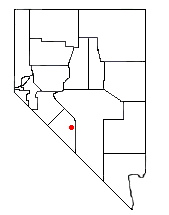Goldfield, Nevada
|
|
Goldfield is a town in Esmeralda County, Nevada, of which it is the county seat. It is about 170 miles south-east of Carson City.
While a small permanent population remains in Goldfield, it is largely a ghost town.
History
Goldfield was incorporated in 1902. It was a boomtown based upon the gold mining industry. It reached a peak population of about 30,000 people in 1906.
In 1904 a lightweight boxing championship match was staged in Goldfield between Joe Gans and Oscar "Battling" Nelson.
In 1906, Goldfield was the origination site of the largest single shipment of gold ore in the world from the Monnette-Hayes Lease on the Mohawk Mine in nearby Tonopah, Nevada.
According to the 1910, United States census, Goldfield had a population of 4838.
The town lies in the midst of a desert abounding in high-grade gold ores, and was essentially a mining camp. The discovery of gold at Tonopah, Nevada, about 28 miles north of Goldfield in 1900 was followed by its discovery at Goldfield in 1902 and 1903; in 1904 the Goldfield district produced about 800 tons of ore, which yielded 2,300,000 United States dollars worth of gold, or 30% of that of the state. This remarkable production caused Goldfield to grow rapidly, and it soon became the largest town in the state.
In addition to the mines, there were large reduction works. In 1907 Goldfield became the county seat. The gold output in 1907 was $8,408,396; in 1908, $4,880,251. Soon after mining on an extensive scale began, the miners organized themselves as a local branch of the Western Federation of Miners, and in this branch were included many labourers in Goldfield other than miners. Between this branch and the mine-owners there arose a series of more or less serious differences, and there were several set strikes in December 1906 and January 1907 for higher wages. In March and April 1907, because the mine-owners refused to discharge carpenters who were members of the American Federation of Labor, but did not belong to the Western Federation of Miners or to the Industrial Workers of the World affiliated with it, this last organization was, as a result of the strike, forced out of Goldfield. In August and September 1907, a rule was introduced at some of the mines requiring miners to change their clothing before entering and after leaving the mines -- a rule made necessary, according to the operators, by the wholesale stealing (in miners’ parlance, "high-grading") of the very valuable ore (some of it valued at as high as $20 a pound). In November and December 1907, some of the mine-owners, avowedly on account of the hard times, adopted a system of paying in cashier’s checks. Except occasional attacks upon non-union workmen, or upon persons supposed not to be in sympathy with the miners’ union, there had been no serious disturbance in Goldfield; but in December 1907, Governor Sparks, at the instance of the mine-owners, appealed to President Theodore Roosevelt to send Federal troops to Goldfield, on the ground that the situation there was ominous, that destruction of life and property seemed probable, and that the state had no militia and would be powerless to maintain order. President Roosevelt thereupon (December 4th) ordered General Frederick Funston, commanding the Division of California, at San Francisco, to proceed with 300 Federal troops to Goldfield. The troops arrived in Goldfield on the 6th of December, and immediately afterwards the mine-owners reduced wages and announced that no members of the Western Federation of Miners would thereafter be employed in the mines. President Roosevelt, becoming convinced that conditions had not warranted Governor Sparks’s appeal for Federal assistance, but that the immediate withdrawal of the troops might nevertheless lead to serious disorders, consented that they should remain for a short time on condition that the state should immediately organize an adequate militia or police force. Accordingly, a special meeting of the legislature was immediately called, a state police force was organized, and on the 7th of March 1908 the troops were withdrawn. Thereafter work was gradually resumed in the mines, the contest having been won by the mine-owners.
The town's four-story Goldfield Hotel opened in 1908 at a cost of $450,000 (in 1908 dollars) and was reported to be the most spectacular hotel in Nevada at the time. At the opening of the hotel, champagne flowed down the front steps in the opening ceremony. The rooms were outfitted with pile carpets, many with private baths, and the lobby was outfitted in solid mahogany. The hotel ceased operations in 1946 but the abandoned building remains there today. The hotel building was used in the 1971 movie Vanishing Point as the site of Super Soul's radio station, KOW. Believers in the paranormal have taken recent interest in the old hotel and believe it to be haunted.
Goldfield's famous residents included Wyatt Earp and Virgil Earp, best known for their earlier role in the Gunfight at the O.K. Corral in Tombstone, Arizona. Wyatt Earp was hired as a deputy sheriff in Goldfield in 1904; Virgil died there of pneumonia in 1905, and Wyatt left Goldfield shortly thereafter.
After some years the gold gradually declined, and most of the population left. By 1912, ore production had dropped to $5 million. The largest mining company left town in 1919.
In 1923 a fire destroyed most of the town's flammable buildings; some brick and stone buildings from before the fire remain including the old hotel.
In 1950 Goldfield had a population of 275.
External links
- Goldfield on GhostTowns.com (http://www.ghosttowns.com/states/nv/goldfield.html)
- Goldfield Nevada home (http://ourworld.cs.com/goldfieldnevada/home.html)
- Goldfield, Nevada, still kicking (http://65.40.245.240/ghosts/goldfld/)
- The Goldfield Strike (http://www.kued.org/productions/fire/goldfield/)

